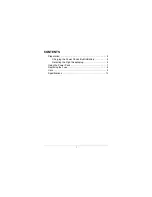
OPERATIONS
THICKNESS PLANING
Thickness planing sizes the workpiece to a desired thickness, while at the same time creating a
smooth and level surface. The thickness of each cut will depend on the type of wood, width of
the workpiece, and condition of the lumber (i.e. dryness, grain composition, straightness, etc).
Always make thin test cuts on a scrap piece of wood prior to performing final cuts.
GENERAL TIPS AND GUIDELINES
1.
Thickness planing always works best when at least one side of the workpiece has a flat
surface. If both sides of the workpiece are rough, feed one face of the board through
the planer until the entire surface is flat.
2.
ALWAYS plane both sides of the workpiece to reach the desired thickness.
3.
DO NOT plane workpieces less than 4.76mm thick, less than 19mm wide, or shorter than
178mm.
4.
It is not recommended to continuously use the planer at its maximum depth of cut
(1.6mm) and at its full width (318mm) as this will shorten the life of the motor.
5.
Light cuts create a smoother finish than heavier cuts.
6.
If a smooth cut is not obtained, see TROUBLESHOOTING GUIDE on page 24.
AVOIDING SNIPE
Snipe, gouging or depression of the board at the ends, can occur when the board is not properly
supported. For workpieces longer than 1.2meter, greater care must be taken to reduce the
problem because the additional length of the workpiece translates into more unsupported weight
pulling down on the end of the board. This unsupported weight will work against keeping the
stock flat. Make sure to use supports or stands whenever long pieces are being planed to avoid
this problem. Since snipe occurs at the end of the boards, it is good practice to start with a
workpiece that is slightly longer than what you need so that you can simply cut off the ends if
necessary. Also see TROUBLESHOOTING for further information.
MAINTENANCE
WARNING! MAKE CERTAIN THAT THE MACHINE IS DISCONNECTED FROM THE
POWER SOURCE BEFORE PERFORMING ANY MAINTENANCE PROCEDURES
Your planer should provide you with a long time of service provided you take the time to
perform the following maintenance operations.
CLEANING
Sawdust buildup and other debris can cause the tool to plane incorrectly. Periodic cleaning
and waxing is needed for accurate, precision planing. Any moving parts should be cleaned
regularly with a penetrating oil and lubricated with a light coating of medium weight machine oil
20
Содержание JWP-12L
Страница 25: ...Exploded View for 10000847M 25 ...
Страница 28: ...Wiring Diagram for 10000847M 28 ...









































